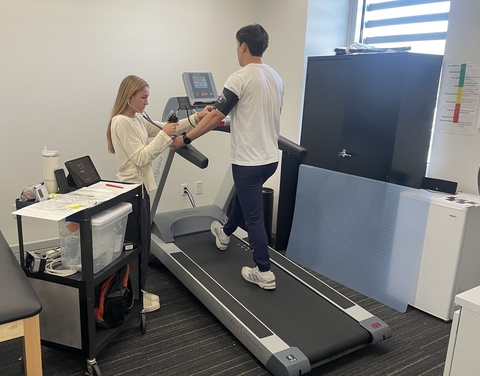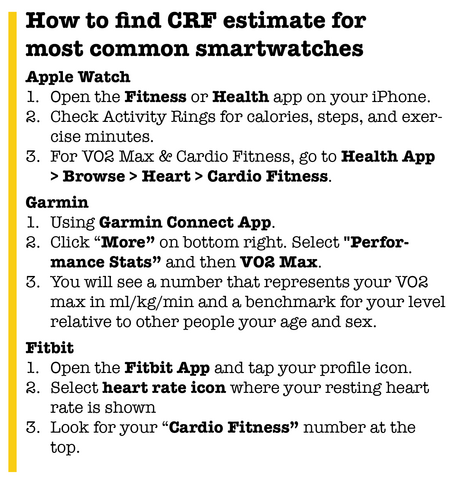By Bryan Madero, graduate student, Behavioral and Cognitive Neuroscience; Hayley Chappell, HBC Lab Exercise Specialist; and Dr. Michelle Voss, HBC Lab Director
There is strong evidence that two key health indicators—blood pressure and cardiorespiratory fitness — play a crucial role in predicting cognitive health as we age. While most of us are familiar with blood pressure, as it is routinely measured during annual physicals, cardiorespiratory fitness may be less well understood. So, what exactly is it?
Cardiorespiratory Fitness (CRF) measures the efficiency of oxygen delivery, consumption, and energy creation from your heart to vital organs during physical exercise. One of the most vital organs that relies on this oxygen is our brain. Although in the average person our brain accounts for only about 2% of our body weight, it accounts for 15-20% of energy consumed through cardiac output and oxygen consumption. In this article, we’ll explain why CRF is important to protect our energy greedy brains, give you tips for estimating and improving your CRF, and discuss how this key measure relates to the information supplied by most wearable devices.
Oxygen and glucose: Your brain’s premium fuel
Expert Dr. Michael Joyner describes CRF as your “aerobic engine size” [1]. Think of oxygen and glucose in your blood as your brain's premium fuel. Most of the time our brain depends on glucose for energy, and when glucose stores are low alternatives like ketone bodies may be used. In either case, the better your heart and lungs work, the more fuel your brain gets to stay strong and active [2, 3].

We can improve CRF through aerobic physical activity, which enhances the body's ability to circulate oxygen in our blood and convert it to energy in our muscles. Studies have shown that increases in CRF are linked to increases in performance on cognitive tests [2, 4]. In addition to brain health and dementia, a higher CRF also predicts lower risk for the most common chronic health conditions such as metabolic dysfunction, heart disease, Alzheimer’s and related dementias, and mortality [5, 6, 7]. Often measured as VO2 max, CRF refers to the capacity for your heart and lungs to deliver oxygenated blood to your muscles for doing physical work. Indeed, VO2 max refers to the maximum volume of oxygen you can convert to work when pushed as hard as you can. While the gold-standard for measuring CRF for people over 40 is a laboratory test of physical work on a treadmill or bike supervised by a physician, we and others are developing tools to estimate CRF based on information you can provide at home.

One example tool can be accessed with the QR code at right . The answer you receive will be a number in the units of ml/kg/min. You may have noticed that sex is a factor in the equation to determine CRF. This is because males have a greater blood volume and oxygen carrying capacity than females do [8]. The number calculated by the tool corresponds to your own “aerobic engine size.” Another tool allows you to see how your CRF ranks compared to others your age and sex [9]. Below 50 for your percentile would indicate your CRF is below average.
Tech tools measure CRF with sensors and algorithms

Wearables like Fitbits, Apple Watches, and Garmin watches can be valuable tools for tracking and understanding your CRF, although they don't directly measure it in the same way a clinical test would. Wearable devices use a combination of sensors and algorithms to estimate your CRF by continuously monitoring your heart rate during workouts and throughout the day, tracking your steps, distance, and the intensity of your workouts using accelerometers, GPS, and heart rate during exercise, and factoring in personal information such as your age, sex, weight, resting heart rate, and other data you provide.
While not as precise as a gold standard maximal exercise test to measure VO2 max, these tools are great for seeing how your personal CRF estimate changes with your weekly and monthly physical activity and sleep patterns. They can also help with motivation by seeing what kinds of lifestyle modifications are moving your CRF up. Beware! Expect it to take several weeks to see changes in CRF that are stable.
We encourage everyone to focus on CRF as an investment in your brain and cognitive health. By engaging in regular physical activity, you can improve your heart and lung function, ensuring that your brain receives the oxygen it needs to stay sharp and active for years to come. So, get moving and fuel your brain with the power of exercise.
Do you use a wearable device to track your fitness? Please click this link to anonymously compare estimated CRF from the tool above with results from your device: HBC Lab Wearable Device Survey
CRF: A Key to Cognitive Function in Aging
In a recent study with older adults, individuals with higher CRF performed better in memory and problem-solving skills – cognitive thinking abilities often negatively affected by aging. This research, part of the IGNITE study, found a positive relationship between CRF and cognitive performance, which was strongest for females and individuals with fewer years of education. Importantly, CRF benefits were not affected by age or genetic risk for Alzheimer's Disease; people aged 65 to 80 – regardless of genetic risk status – had similarly positive benefits from CRF [10].
It is also worth noting that participants in this study had mostly low to average CRF levels, so even getting closer to average is beneficial. This highlights the potential for even modest improvements in CRF to positively impact cognitive health in older adults.
How to improve your CRF and boost your brain function
So, how can you improve your CRF and reap these brain-boosting rewards? The answer is simple: get moving! Every minute of physical activity counts. Whether it's a brisk walk, a bike ride, or a swim, regular physical activity that gets your heart rate up will benefit your CRF and thus can help your brain and cognition thrive [3, 11].
Don't feel pressured to become a Masters endurance athlete. Start small – try a brisk 10-minute walk today and build a routine that regularly fits into your day. Consistency is key. Find activities you enjoy so that you look forward to finding that time in your daily or weekly routine. As your CRF improves, you can gradually increase the intensity and duration of your workouts. For walks, this might look like adding a little extra weight to a backpack (great to get ready for travel), extending your route to include more hills or some stairs, or give yourself a challenge to go a little faster on a couple stretches of road or path.
We encourage everyone to focus on CRF as an investment in your brain and cognitive health. By engaging in regular physical activity, you can improve your heart and lung function, ensuring that your brain receives the oxygen it needs to stay sharp and active for years to come. So, get moving and fuel your brain with the power of exercise.
References:
- For a long and detailed discussion including an in-depth explanation of cardiorespiratory fitness, see this podcast discussion with Dr. Joyner: https://peterattiamd.com/mikejoyner/
- Voss, M. W. et al. (2019). Exercise and Hippocampal Memory Systems. Trends in Cognitive Sciences. doi: 10.1016/j.tics.2019.01.006
- Powell, K. E., et al. (2018) The scientific foundation for the physical activity guidelines for Americans. Journal of Physical Activity and Health. doi: https://doi.org/10.1123/jpah.2018-0618
- Erickson, Kirk I., et al. (2019) Physical activity, cognition, and brain outcomes: a review of the 2018 physical activity guidelines. Medicine and science in sports and exercise. doi: 10.1249/MSS.0000000000001936
- Lee J. (2021). Influence of Cardiorespiratory Fitness on Risk of Dementia and Dementia Mortality: A Systematic Review and Meta-Analysis of Prospective Cohort Studies. Journal of aging and physical activity, 29(5), 878–885. https://doi.org/10.1123/japa.2019-0493
- Tari, A. R., Nauman, J., Zisko, N., Skjellegrind, H. K., Bosnes, I., Bergh, S., Stensvold, D., Selbæk, G., & Wisløff, U. (2019). Temporal changes in cardiorespiratory fitness and risk of dementia incidence and mortality: a population-based prospective cohort study. The Lancet. Public health, 4(11), e565–e574. https://doi.org/10.1016/S2468-2667(19)30183-5
- Lee, J., Song, R. J., Musa Yola, I., Shrout, T. A., Mitchell, G. F., Vasan, R. S., & Xanthakis, V. (2021). Association of Estimated Cardiorespiratory Fitness in Midlife With Cardiometabolic Outcomes and Mortality. JAMA network open, 4(10), e2131284. https://doi.org/10.1001/jamanetworkopen.2021.31284
- Diaz-Canestro, C., Pentz, B., Sehgal, A., & Montero, D. (2022). Sex differences in cardiorespiratory fitness are explained by blood volume and oxygen carrying capacity. Cardiovascular research, 118(1), 334–343. https://doi.org/10.1093/cvr/cvab028
- https://www.kumc.edu/research/alzheimers-disease-research-center/fitness-ranking.html
- Oberlin, L. E., et al. (2024). Cardiorespiratory fitness is associated with cognitive function in late adulthood: baseline findings from the IGNITE study. British Journal of Sports Medicine. doi: 10.1136/bjsports-2024-108257
- Piercy, K. L., et al. (2018) The physical activity guidelines for Americans. Journal of the American Medical Association. doi: 10.1001/jama.2018.14854